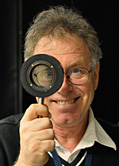Optically Probing the Nanoarchitecture of Cells and Tissues
Category
Published on
Abstract
The wavelengths of light are comparable to the sizes of structures in cells and tissues, and consequently there is strong interaction of light with tissues. Interactions on the 1-10 nm scale can influence fluorescence, fluorescent lifetime, and second-harmonic generation (SHG). Interactions on the 50-1000 nm scale influence photon scattering. This seminar presents our current work on using light to probe the nanoarchitecture (1-1000 nm) of cells and tissues. In particular, our experiments with SHG and holographic imaging of angular scattering of photons explore the structure of collagen fibers. Our work with confocal reflectance yields the scattering coefficient and anisotropy of scattering in tissues. Our work on the relationship between fractal size distribution of scatterers and the wavelength dependence of optical scattering allows macroscopic optical spectroscopy to characterize nanoscale tissue structure.
Bio
 Stephen Jacques is professor for Biomedical Engineering and Dermatology in the School of Medicine at Oregon Health and Sciences University (OHSU).
Stephen Jacques is professor for Biomedical Engineering and Dermatology in the School of Medicine at Oregon Health and Sciences University (OHSU).
His background includes biology, biochemistry and electrical engineering.
His current research areas are biomedical optics developing new uses of lasers and light in medicine and biology, and electrical sensing and characterization of biomaterials.
Sponsored by
Cite this work
Researchers should cite this work as follows:
Time
Location
Physics, Room 203, Purdue University, West Lafayette, IN